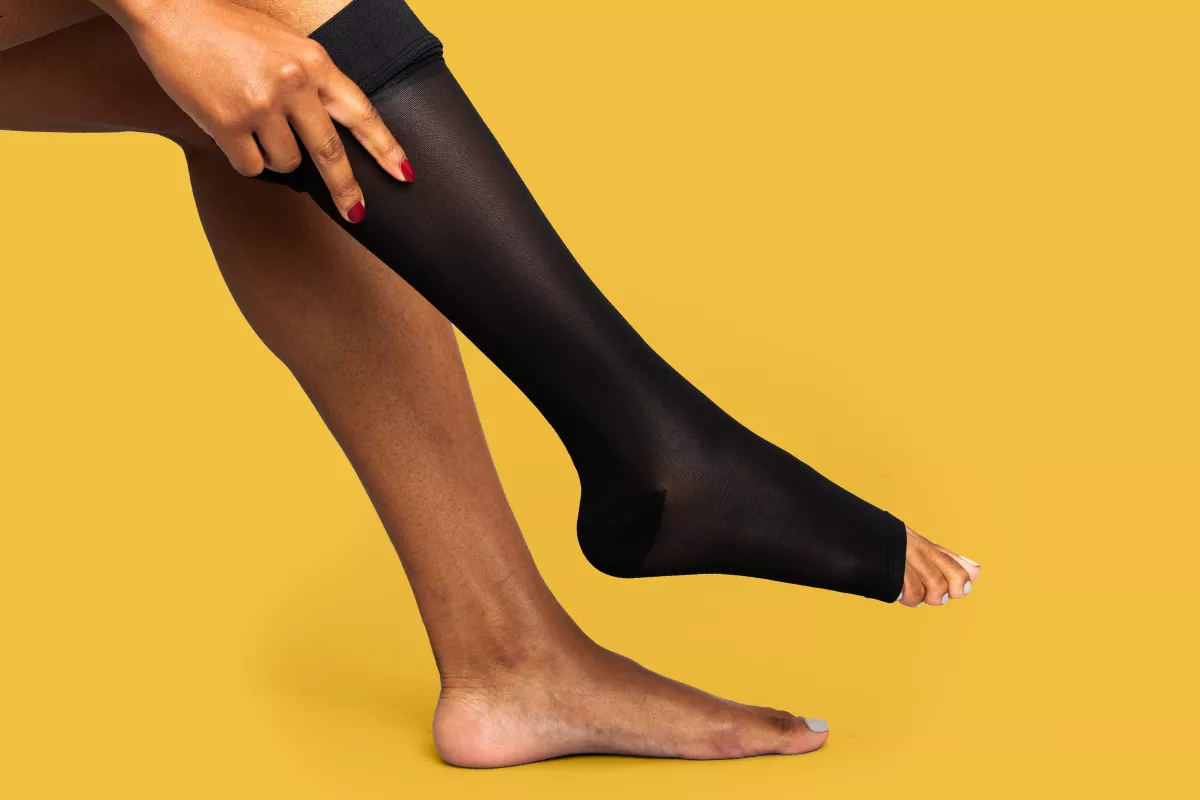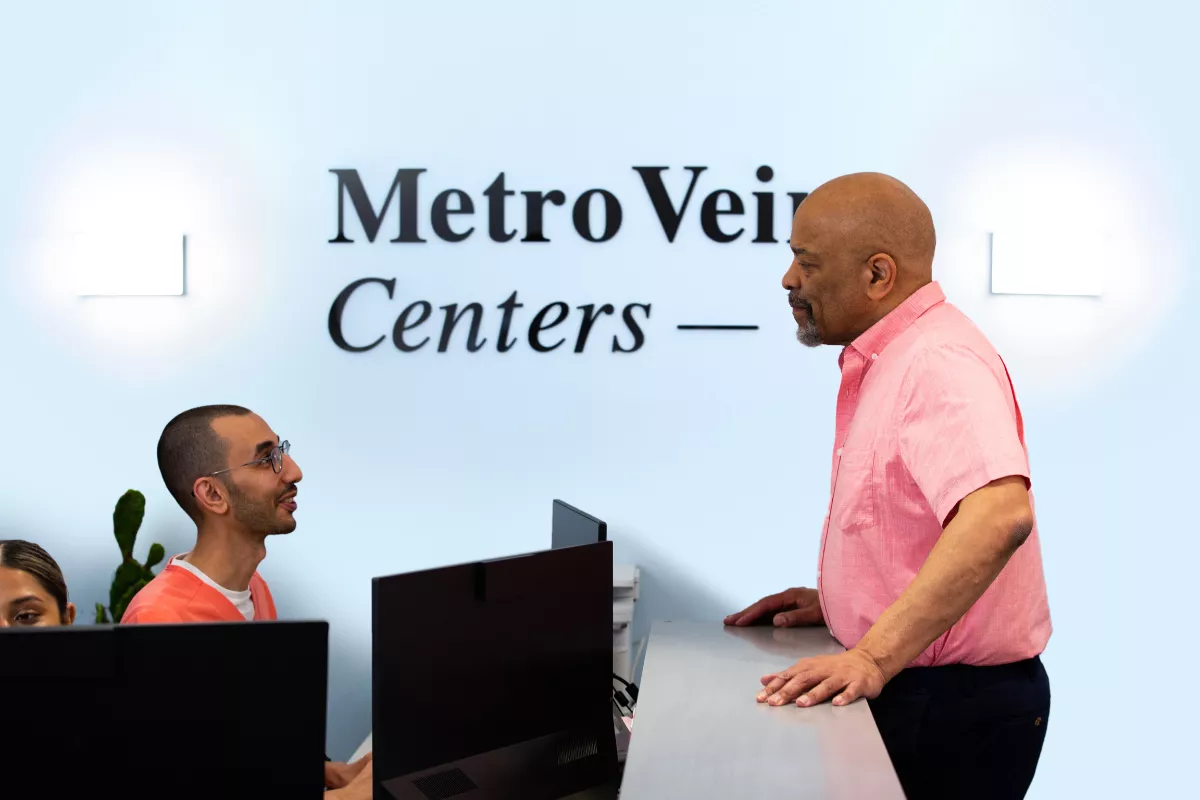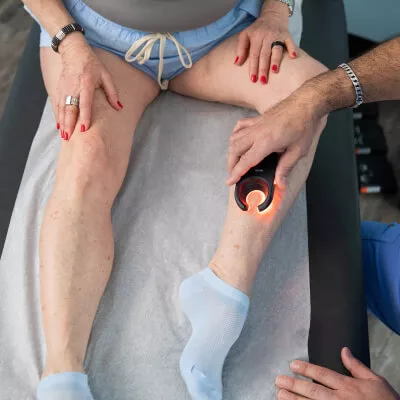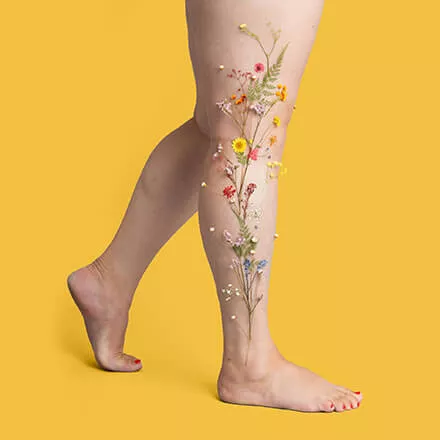Varicose veins and poor circulation are common vascular issues that affect a significant portion of the population. In fact, 1 in 3 people will be diagnosed with some form of vein disease during their lifetime! These conditions can lead to discomfort, pain, and even more severe complications if left untreated, due to the progressive nature of chronic venous insufficiency (aka vein disease).
There are a number of modern vein treatment options, such as radiofrequency ablation and sclerotherapy, that can provide permanent relief from these symptoms. However, for those interested in at-home treatment options, compression stockings may help alleviate symptoms associated with varicose veins and can be used proactively at-home or as a follow-up to vein treatment. In this comprehensive guide, we'll delve into how compression stockings impact varicose veins and spider veins, promote good blood circulation, and play a critical role in the vein treatment process.
Do Compression Socks Prevent Varicose Veins?
Compression socks can help prevent varicose veins by improving blood circulation and reducing the backup of blood in the veins. They apply pressure to the legs, which helps veins function properly and prevents blood from pooling. Regular use can alleviate symptoms and support vein health.

Understanding Varicose Veins and Poor Circulation
To understand how compression stockings can help, it's important to first talk about the reason varicose veins form. Varicose veins are enlarged, twisted visible veins that often appear blue, green, red, or purple, depending on skin tone. Varicose veins typically occur in the legs, where veins must fight against gravity to return blood upward to the heart and lungs. If valves within the veins are weakened, the blood flow may cause excessive strain, and negatively affect circulation. This leads to blood pooling (also referred to as "stagnant blood") and an increase in pressure that may distort healthy veins, producing varicose veins.
Poor circulation refers to a failure in the circulatory system: inadequate blood flow through the blood vessels, preventing efficient nutrient and oxygen delivery to various parts of the body. Poor circulation may be marked by swelling in extremities (most notably in the feet and ankles), cold fingers and toes, and physical color changes to skin (feet may be a bit blue or purple, depending on how fair or deep your complexion is). These conditions often occur together, as poor circulation is one of the most common causes of vein disease. Symptoms may include pain while standing, leg swelling (aka edema), restless legs, and aching or heaviness in the legs.

Putting the Pressure On (Literally)
Compression therapy is using specially designed garments, called compression stockings or compression socks, to apply gentle upward pressure to the legs. These garments are made from elastic materials that exert graduated pressure, meaning the pressure is strongest at the extremities and gradually decreases as it moves upward on the leg. Typically, a measurement of 20-30 mmHgs of graduated pressure is recommended for optimal results. (This is typically labeled as a "firm" option when shopping online for compression stockings.) Compression helps improve blood circulation and alleviate the symptoms associated with varicose veins and poor circulation (namely, swelling/edema in the legs) by mimicking muscular pressure on veins in the legs. This makes it a convenient solution to improving circulation for those who lead more sedentary lifestyles, as well as those who sit or stand for extended periods of time. Wearing compression stockings has a similar effect on your circulation as doing calf raises or walking (but with no cardiovascular benefit, so please consider this an additional health tool, not a substitute for exercise).

Getting Blood Flowing
Compression socks uniquely tackle many factors that contribute to the pain and discomfort experienced with vein disease. Their support helps to minimize discomfort in multiple ways, including:
Enhancing blood flow: The primary perk of compression stockings is their ability to improve the efficacy and ease of blood flow. The graduated pressure exerted by compression garments assists the veins in pumping blood back towards the heart, counteracting the effects of gravity. Think of this metaphor: Compression is like adding another person to the team when pushing a boulder up a hill. Improving circulation reduces the pooling of blood in the veins and alleviates symptoms like swelling and discomfort -- the reduction is often visible in the case of edema in the feet and ankles.
Reducing vein pressure: Compression stockings effectively support the walls of the veins and prevents them from expanding excessively under the strain of pooling blood. This reduction in pressure promotes the efficient return of blood to the heart and lungs, decreasing the strain on the vascular system and reducing the risk of healthy veins becoming varicose veins.
Preventing blood clot formation: Promoting consistent blood flow minimizes the risk of stagnant blood, which is a key factor in clot formation. This is particularly important for individuals with poor circulation, as they are more susceptible to clot-related complications, and those already diagnosed with chronic venous insufficiency. The vein support provided by compression stockings discourages the formation of blood clots.
Minimizing swelling and edema: Compression stockings helps reduce swelling and edema -- common symptoms of varicose veins and poor circulation -- by preventing the accumulation of excess fluid in tissue when caused by leaking veins. The pressure exerted by compression garments encourages the movement of fluid away from the affected areas, promoting a more balanced and healthy fluid distribution. Similar results can be achieved through elevation during leisure or rest time. However, compression stockings can be worn throughout the day, allowing for more freedom of movement.

When to Wear Compression Stockings
Compression stockings have a lot of appeal, as they can help maintain your comfort levels at home. Board-certified vein specialists recommend compression stockings after sclerotherapy and other vein treatments for a variety of clinical reasons, including:
When traveling: Wearing compression stockings during extended periods of sitting or standing, such as on public transportation like subways, trains, and buses, as well as when flying on airplanes with a change in air pressure, can be of great benefit to your veins. Compression during periods of immobility helps to encourage your veins to pump blood against the force of gravity, not unlike how our calf muscles promote blood flow when we walk or exercise. Compression stockings can reduce swelling and discomfort on airplanes, especially when paired with some light movement. Walking up and down the aisle, stretching, and wearing compression socks while flying can drastically reduce discomfort -- and your veins will thank you!
At-home support: Although compression stockings cannot permanently prevent varicose veins or the inevitable progression of vein disease, they can provide temporary relieft of symptoms such as aching, swelling, and heaviness. Individuals at risk of varicose veins (such as those with a family history of venous issues or those who spend extended periods sitting or standing) can benefit from wearing compression garments to maintain healthy circulation.
After vein treatment: Compression therapy is often recommended to wear for a few days after vein treatment. Compression aids in reducing post-treatment swelling, promotes faster healing, and improves circulation following vein treatment. At Metro Vein Centers, compression socks are provided after all varicose vein treatments excluding Venaseal™ (because this vein treatment applies pressure from within the vein, thereby eliminating the need for external compression).
As part of lifestyle changes: Incorporating compression therapy into a comprehensive vein care plan is a valuable component of a healthy lifestyle. It complements other measures such as regular exercise, a balanced diet, and avoiding prolonged periods of sitting or standing. By integrating compression stockings into daily routines, individuals can actively manage their vascular health and mitigate the impact of varicose veins and poor circulation from home, and covertly during work or travel when worn underneath regular clothing.

Longer-term Solutions Are Available
Compression therapy stands as a cornerstone in the conservative management of varicose veins, but it is not designed to be a permanent solution for treating varicose veins. Compression can enhance blood flow, reduce vein pressure, and minimize swelling -- which makes it a versatile and effective solution for individuals seeking at-home treatment options for vascular health. However, because varicose veins are a result of damaged valves in the veins that cannot be cured without treatment, it's important to note that lasting relief can only be achieved through minimally invasive vein treatment options such as radiofrequency ablation (RFA), endovenous laser ablation (EVLA), sclerotherapy, Venaseal™, and varithena. Because vein disease is progressive (meaning it will worsen with time if left untreated), our vein specialists recommend coming in for a free vein evaluation and beginning a custom treatment plan to permanently treat unhealthy varicose veins once and for all!
Whether used as a standalone treatment or as part of a comprehensive vein care plan, compression therapy empowers individuals to take proactive steps towards maintaining optimal circulation and enjoying a life free from the discomfort associated with vascular issues. As a convenient at-home treatment to improve circulation, compression therapy is a great option for people struggling with the early stages of leg pain, heaviness, or swelling. From the comfort of your home or as you're leaving the clinic, we highly recommend incorporating compression stockings into your treatment plan!

If you're looking for lasting relief, we've got you covered. We offer free vein evaluations in all of our New York, New Jersey, Connecticut, Michigan, Texas, and Arizona vein clinics. Our board-certified team of vein specialists provides FDA-approved, minimally invasive vein treatments for both varicose veins and spider veins. We accept over 200 insurance plans for our varicose vein treatments. All of our state-of-the-art vein treatments are performed in under 30 minutes, in our accredited vein clinics, by our certified vein doctors. Give us a call at 866-353-5558 to get started on the journey to healthy, happy legs!

Metro Vein Centers Editorial Team
From vein care 101 to treatments, the Metro Vein Centers blog offers patients everything they need to know about vein health.

Trusted insight from the nationally accredited, board-certified vein doctors at Metro Vein Centers.







